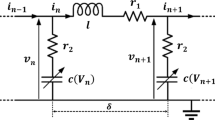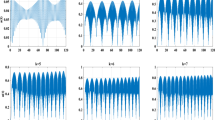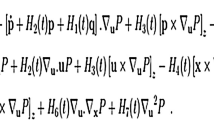Abstract
This contribution attempts to review certain resonance effects which occur in the dynamic behaviour of semiconductor lasers. To study these effects theoretically, a rate equation approach is used for single-mode operation in the region of lasing threshold.
The two basic rate equations are given and their transient solutions discussed. The existence of two time constants in these equations, viz. the electron lifetimeτ e and the photon lifetimeτ e; gives rise to a characteristic resonance frequency in the GHz region. This resonance manifests itself in transient ‘spiking’ effects, in quantum noise phenomena, and in high-frequency modulation experiments. In a modified form the resonance frequency may also be studied in lasers with external cavities and in double-diode configurations (or, equivalently, conventional devices with non-uniform excitation along the cavity length).
In the latter two examples mentioned above, the resonance is excited by optical feedback of the laser radiation into the active medium via a ‘lossy’ or insufficiently inverted region. In the ‘spiking’ oscillations commonly observed at the commencement of laser operation, the initial ‘population overshoot’ is the cause of the resonance. For the case of quantum noise it is the requirement that the photon and electron populations have integer values which supplies the driving force-a true quantum effect. High-frequency modulation experiments directly reveal the same resonance frequency where a strong maximum in modulation intensity occurs.
Similar content being viewed by others
References
G. J. Lasher,Solid State Electronics 7 (1964) 707–716.
H. Statz, C. L. Tang, andJ. M. Lavine,J. Appl. Phys. 35 (1964) 2581–2585.
J. Vilms, L. Wandinger, andK. L. Klohn,IEEE J. Quant. Elect. QE-2 (1966) 80–83.
N. G. Basov,ibid QE-4 (1968) 855–864.
H. Haug,Phys. Rev. 184 (1969) 338–348.
M. J. Adams,Phys. stat. sol. (a) 1 (1970) 143–152.
M. Cross, to be published.
M. J. Adams,Solid State Electronics 12 (1969) 661–669.
A. R. Goodwin andG. H. B. Thompson,IEEE J. Quant. Electr. QE-6 (1970) 311–312.
A. R. Goodwin andP. R. Selway,ibid QE-6 (1970) 285–290.
E. Pinkas, B. I. Miller, I. Hayashi, andP. W. Foy,J. Appl. Phys. 43 (1972) 2827–2835.
F. Stern,Phys. Rev. 148 (1966) 186–194.
M. J. Adams,Brit. J. Appl. Phys. (J. Phys. D)2 (1969) 1549–1553.
C. J. Hwang,Phys. Rev. B2 (1970) 4126–4134.
M. Ettenberg andH. Kressel,J. Appl. Phys. 43 (1972) 1204–1210.
V. D. Kurnosov, V. I. Magalyas, A. A. Pleshkov, L. A. Rivlin, V. G. Trukhan andV. V. Tsvetkov, Soviet Physics —JETP Letters 4 (1966) 303–305.
R. Roldan,Appl. Phys. Letts. 11 (1967) 346–348.
J. R. Andrews, reported at the Fibre Optics Communications Meeting, London (1972).
J. C. Dyment, J. E. Ripper, andT. P. Lee,J. Appl. Phys. 43 (1972) 452–457.
J. E. Ripper,ibid 43 (1972) 1762–1763.
D. E. Mccumber,Phys. Rev. 141 (1966) 306–322.
H. Haug andH. Haken,Z. Phys. 204 (1967) 262–275.
D. J. Morgan andM. J. Adams,Phys. stat. sol. (a) 11 (1972) 243–253.
L. A. D'asaro, J. M. Cherlow, andT.L. Paoli,IEEE Jl. Quant. Electr. QE-4 (1968) 164–167.
T. L. Paoli andJ. E. Ripper,Phys. Rev. A2 (1970) 2551–2555.
T. Ikegami andY. Suematsu,IEEE Jl. Quant. Electr. QE-4 (1968) 148–151.
E. Mohn,Electronics Letters 5 (1969) 261–262.
T. Ikegami andY. Suematsu,Proc. IEEE 55 (1967) 122–123.
Idem, Electronics and Communications in Japan 53-B (1970) 69–75.
M. J. Adams, Proceedings of the International Conference on ‘Lasers and their Applications’, Dresden, DDR (1970) 743–753.
K. Konnerth andC. Lanza,Appl. Phys. Letts. 4 (1964) 120–121.
G. Guekos andM. J. O. Strutt,Electronics Letters 3 (1967) 276–277.
H. D. Edmunds, C. DePalma andE. P. Harris,Appl. Optics 10 (1971) 1591–1596.
E. Mohn, R. F. Broom, Ch. Deutsch, andJ. Hatz,Phys. Letts. 24A (1967) 561–564.
R. F. Broom, E. Mohn, C. Risch andR. Salathé,IEEE Jl. Quant. Electr. QE-6 (1970) 328–334.
E. Mohn, Proceedings of the International Symposium on ‘Gallium Arsenide’, Dallas, Texas (IPPS, London), (1968) 101–109.
R. F. Broom andE. Mohn,J. Appl. Phys. 39 (1968) 4851–4852.
E. P. Harris,ibid 42 (1971) 892–893.
O. V. Bogdankevich, A. N. Mestvirishvili, A. N. Pechenov, andA. F. Suchkov, Soviet Physics —JETP Letters 12 (1970) 128–129.
C. A. Brackett,IEEE Jl. Quant. Electr. QE-8 (1972) 66–69.
T. L. Paoli andJ. E. Ripper,Phys. Rev. Letts. 22 (1969) 1085–1088.
Idem, Appl. Phys. Letts. 15 (1969) 105–107.
J. E. Ripper andT. L. Paoli,ibid 18 (1971) 466–468.
Idem, IEEE Jl. Quant. Electr. QE-8 (1972) 74–80.
N. G. Basov, V. N. Morozov, V. V. Nikitin, andA. S. Semenov, Soviet Physics —Semiconductors 1 (1968) 1305–1308.
Yu. m. Popov, G. M. Strakhovskii, andN. N. Shuikin,ibid 3 (1970) 943–947.
T. P. Lee andR. Roldan,IEEE Jl. Quant. Electr. QE-5 (1969) 551–552.
Idem, ibid QE-6 (1970) 339–352.
Yu. A. Drozhbin, Yu. P. Zakharov, V. V. Nikitin, A. S. Semenov, andV. A. Yakovlev, Soviet Physics —JETP Letters 5 (1967) 143–145.
K. Kobayashi, H. Yonezu, F. Saito, andY. Nannichi,Appl. Phys. Letts. 19 (1971) 323–324.
T. L. Paoli andJ. E. Ripper,Proc. IEEE 58 (1970) 1457–1465.
I. Hayashi, M. B. Panish, P. W. Foy, andS. Sumski,Appl. Phys. Letts. 17 (1970) 109–111.
Zh. I. Alferov, V. M. Andrew, D. Z. Garbuzov, Yu. V. Shilyaev, E. P. Morozov, E. L. Portnol, andV. G. Trofim, Soviet Physics —Semiconductors 4 (1971) 1573–1575.
J. C. Dyment, L. A. D'asaro, J. C. North, B. I. Miller, andJ. E. Ripper,Proc. IEEE 60 (1972) 726–728.
T. Tsukada, H. Nakashima, J. Umeda, S. Nakamura, N. Chinone, R. Ito, andO. Nakada Appl. Phys. Letts. 20 (1972) 344–345.
Author information
Authors and Affiliations
Additional information
A part of this work was reported at the Conference on ‘Semiconductor Injection Lasers and their Applications’, Cardiff, March 1972.
Rights and permissions
About this article
Cite this article
Adams, M.J. Rate equations and transient phenomena in semiconductor lasers. Opto-electronics 5, 201–215 (1973). https://doi.org/10.1007/BF01414739
Received:
Revised:
Issue Date:
DOI: https://doi.org/10.1007/BF01414739




